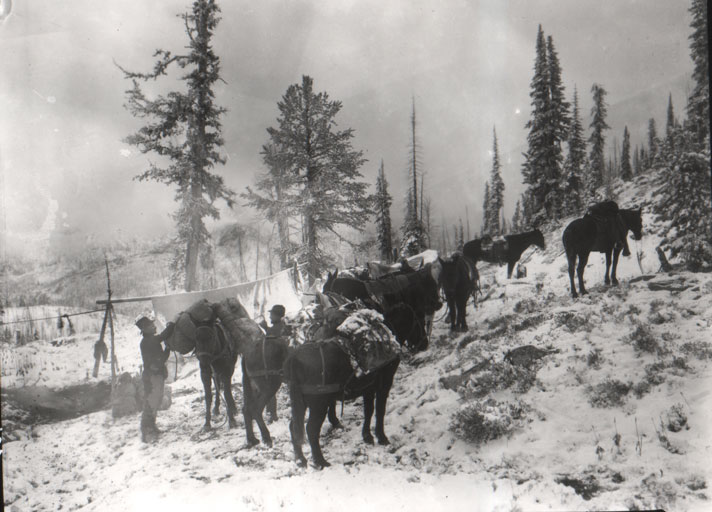Pioneer Profiles – February 2017
Although a close to record snow fall on January 3, 2017, had local residents digging out from under up to 20 inches of the white stuff, that “storm of the century” may not compare to some of the snows experienced in Southern Oregon before formal record keeping began. One winter in particular comes to mind—the winter of 1852, also known as the winter of hardships, starvation, and privation.
Gold had been discovered near Jacksonville in either December 1851 or January 1852, (see “Pioneer Profiles,” www.historicjacksonville.org or Jacksonville Review, February 2014) bringing thousands of miners seeking riches. Free land available under the Donation Land Act brought farmers and settlers to the new Oregon Territory in search of a better life. By the fall of 1852, the Rogue Valley had seen an influx of new arrivals. Estimates of the number of people living in or near Jacksonville and engaged in mining or farming at that time vary from 3,000 to 10,000.
Even as these pioneers scrambled to stake claims and build shelters, winter broke early and mean. By early December the snow was piling up—2 ½ feet deep in the valley; 10 feet deep over the mountain passes. All the trails were blocked so travel was cut off.
Of course no one had anticipated this kind of winter weather—after all, this was Oregon, not New England. And Southern Oregon, from the Umpqua south to Shasta County, was primarily a mining region, being worked and traveled by thousands of miners who depended entirely on imported supplies. The snow left everyone facing short rations.
The merchants had no extra supplies; few of the miners had stocked up for winter; newcomers who had just crossed the Oregon Trail had only their remaining supplies; and those who had arrived a year earlier had only been able to produce a very limited quantity of supplies, certainly not enough to meet the demand. So prices skyrocketed.
An 1867 Oregon Sentinel article recalled the situation.
“All emigration and supplies from Northern to Southern Oregon, 1852, had to pass through the celebrated Canyon
By year end, there was no more beef or gunpowder to be had. Salt was literally worth its weight in gold and not to be had even at that price. And some prominent local citizens were accused of hoarding or jacking up prices on the supplies they had.
In January, the snow finally turned to rain which only made things worse. The resulting floods were washing out trails, bridges, and, of course, mining claims. Any supplies that made it to Jacksonville had to be packed on mules down from Salem—through all the rain, flooded rivers, and canyons.
The combination of weather, exposure, and malnourishment contributed to miners and settlers becoming ill. Local women nursed the sick as best they could, using dried herbs to brew medicinal teas and begging all the cloth flour sacks they could get. By soaking the sacks in water, they could obtain any residual flour in the corners which they used to cook up a thin gruel that provided some nourishment.
Most settlers and miners subsisted on “venison straight,” as they termed it—unsalted deer meat. Pioneer George E. Cole recalled the following:
“The crust on the snow would bear up a man, but the sharp feet of the deer would cut through it, impeding their progress to such an extent that they could not escape their pursuers, and were overtaken and killed by footmen with axes. This condition was fortunate for the miners, as they had no ammunition with which to shoot them. Venison without salt or bread or bacon or beans was in most instances their only food for several weeks.”
When a mule load of salt arrived from Scottsburg, an enterprising local merchant, Dan Kinney—partner in Kinney & Apler, Jacksonville’s first “house of commerce”—met the packer before he could reach town and bought the entire 250 pound load for $8 per pound. Hearing of this, the miners and citizens of Jacksonville held a meeting and passed a law, “regulating” the price of salt. The merchant was “requested” to sell this salt at a maximum price of one ounce of gold ($16) per pound and limit quantities to one pound per person.
Men stood in line and handed their gold dust to one of the partners to be weighed while the other partner weighed out the salt and handed it to the purchaser. “In many instances three or four persons would club together, and as soon as the salt was obtained, they would reach out their hands for a portion of it, and eat it as a child would sugar.”
What became known as “the starving time” finally ended in late March of 1853 as the first pack trains of supplies began to arrive. According to a report in the April 23, 1853 Oregon Statesman, the first flour that came in sold for $1.25 per pound, nominally, but in reality about two dollars since some of it had become wet in transport. Salt sold for $4 per ounce; coffee and sugar for $2 per pound. An enterprising merchant met the first train about 35 miles from town and bought 200 pounds of tobacco for $1,000. He subsequently sold it for $10 per pound.
Though we may have been inconvenienced by our record snow fall, it’s hard to even imagine what local pioneers experienced 160 years ago. I may have been “suffering” from boredom and “cabin fever” after being snowbound for seven days, but I at least I had the benefit of electricity and a well-stocked refrigerator!
